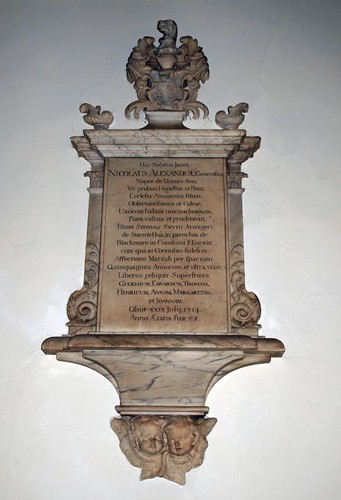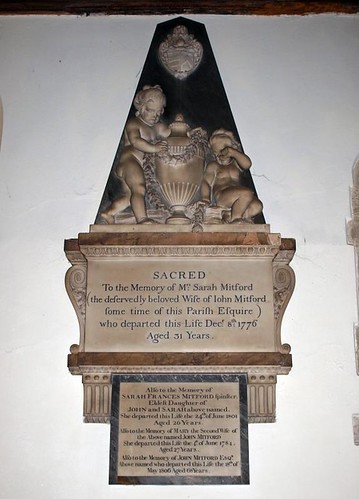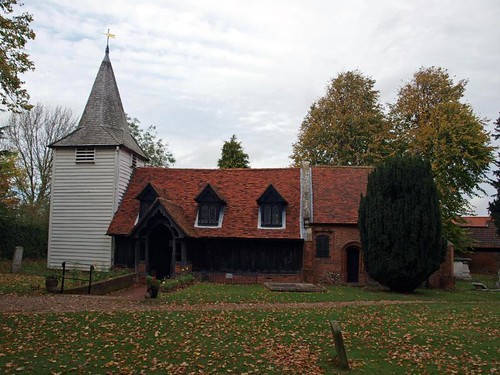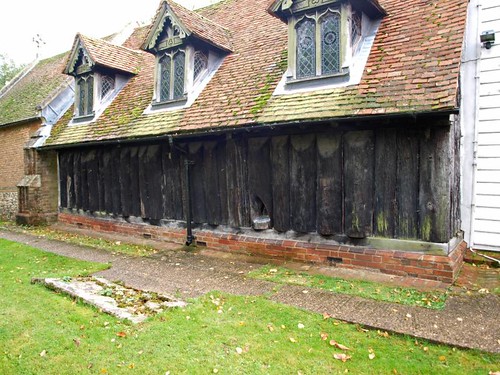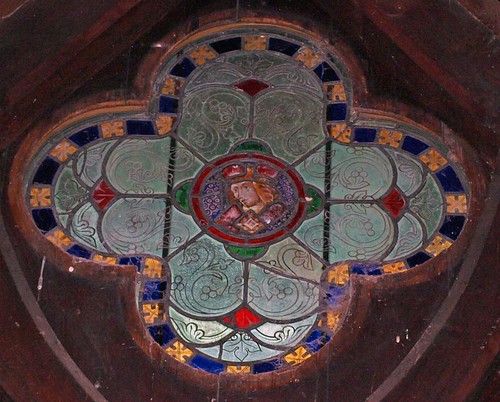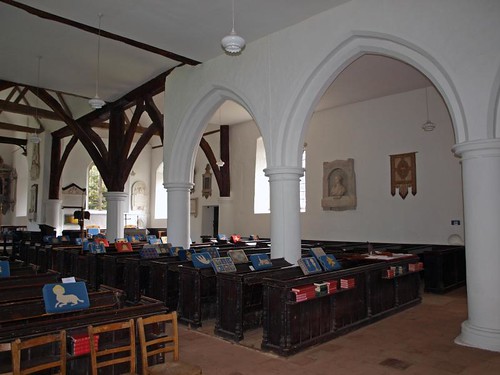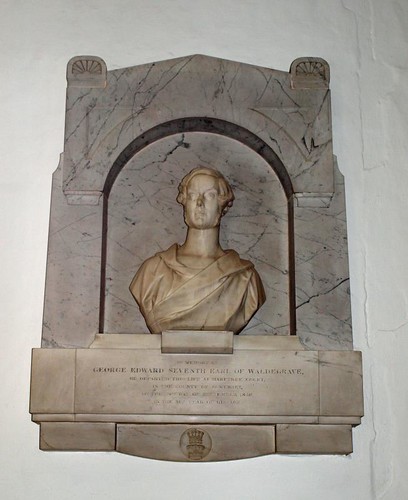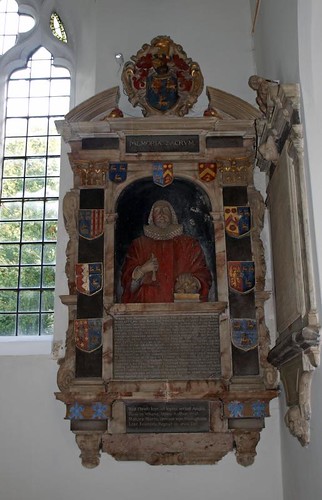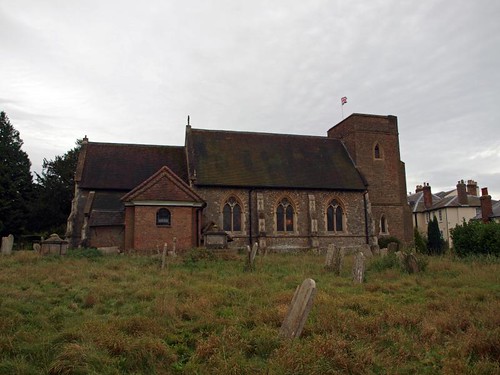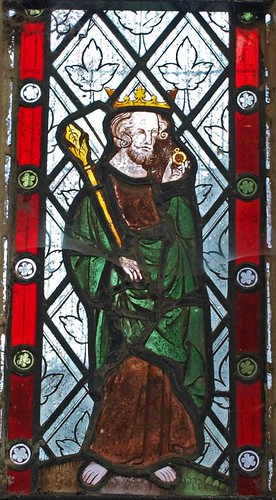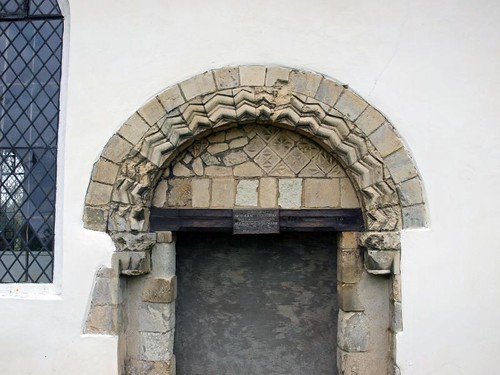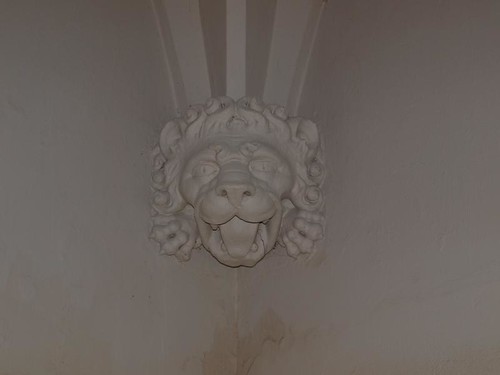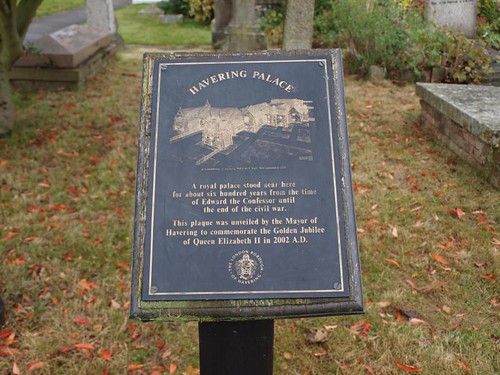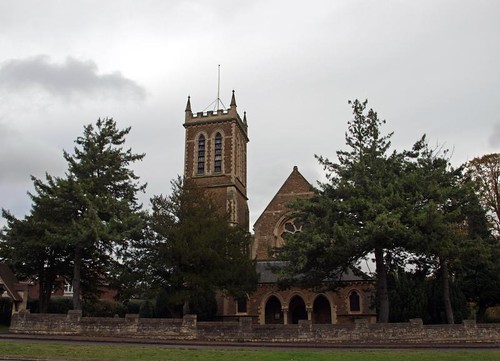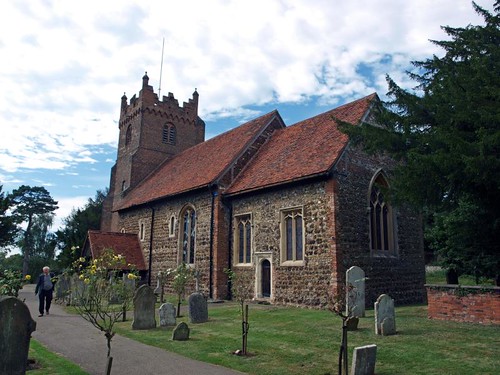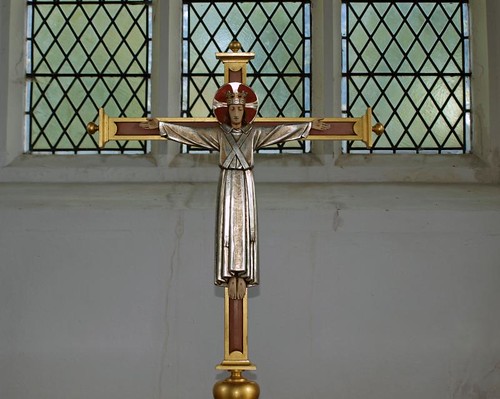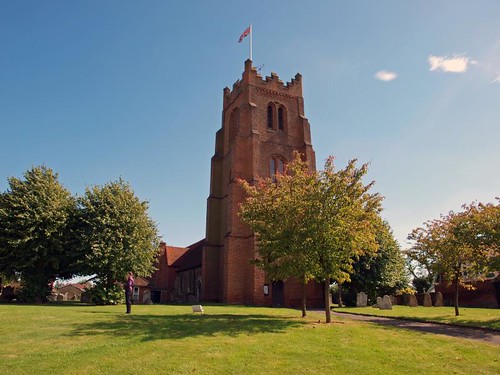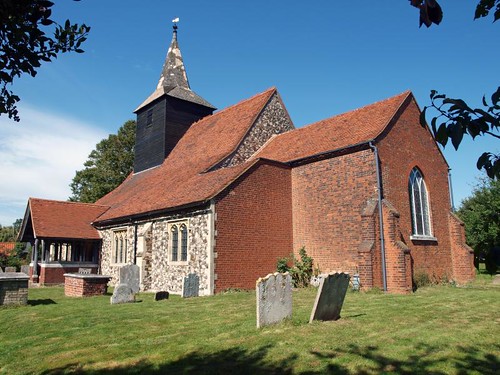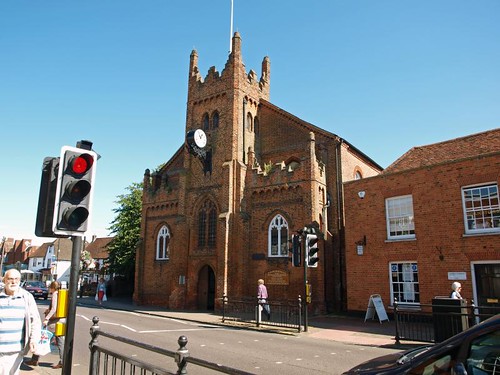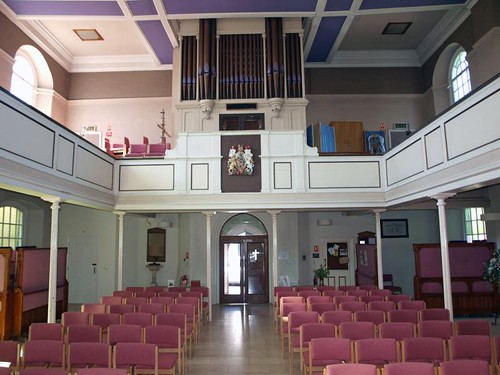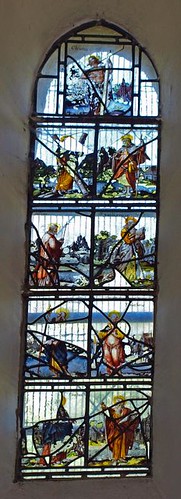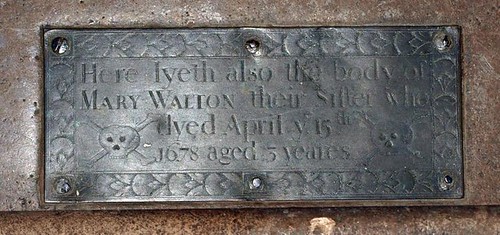ST MARTIN of TOURS. Uncommonly complete Norman village church. Nave and chancel, both with characteristic masonry, Roman brick quoins, and small windows. Two plain chancel doorways also survive, and a W window high up in the gable. The E end is altered, but traces, especially inside, prove that there were originally three or four windows and two above them in the gable which was higher than now. The date of the belfry is probably C15. Dormers in the roof 1752 (VCI-I.). The S aisle was added in 1884. Nice W gallery on two Tuscan columns. Chancel roof with arched braces supporting collar-beams and additional arched braces carried to a pendant hanging from the collar-beam. The Royal Commission dates the roof early C17. The nave-roof is simple, with arched braces on head-stops and tracery between the braces and the tie-beams. King-posts in addition. - PULPIT. Panels with diamond-cut frames and thin strapwork, c. 1600. - COMMUNION RAIL. With twisted balusters, c. 1700. - PLATE. Paten of 1705. - MONUMENTS. Nicholas Alexander d. 1714, epitaph with two cherub’s heads at the foot. It might be by Edward Stanton. - Mrs Mitford d. 1776. By Nollekens. Epitaph with the usual obelisk and two cherubs against it and an urn between them; one stands, the other sits and sobs.
CHIPPING ONGAR. It is one of those small Essex towns instinct with the thrill of history. One after another there come to mind the moving scenes of its historic past. To some it will seem that the chief appeal of this long street with gabled houses and overhanging storeys is in a little room the passer-by is invited to look at, the room in the house of a pastor where David Livingstone lived, serving his probation before he set out on his lifework in Africa. The boy at the mill had come down from Blantyre and was training here with the minister, and there may well be those who remember hearing of the nervous young man who had hardly strength to lead his congregation at prayer, who gave out hymn after hymn while he summoned up courage to preach and then fled down the steps and into the street, afraid. Yet in the end he passed the test, and from here set out to carry on his preparation elsewhere for the work which was to win him immortality.
But far, far back we go beyond the fame of David Livingstone, for here is a mound crowned by a ring of living trees where once stood the wooden keep of a Norman castle, and there is little doubt that a castle stood on it before the Conqueror came, for in its walls is a medley of Roman tiles which strongly suggest that they were put here by the Saxons. On such foundations as they found the Romans set up one of their great strongholds. The mound is 230 feet across, encircled by a moat 50 feet wide, with the water still in it. On the town side was a courtyard with a rampart 80 feet wide, and even beyond this men have traced a rampart which embraced the whole of Ongar, a remarkable example of a town enclosure of feudal days.
Here lived one of the famous Norman barons, Richard de Lucy, Chief Justice in the reign of Henry the Second. He took the side of the king against Becket, and Becket excommunicated him. Weary of strife, the judge became a canon in a priory he had founded in Kent, Lesnes Priory at Erith, within whose quiet walls he died. Across the Darent, not far away from the ruins of Lesnes, are the ruins of the castle of another friend of the king excommunicated by Becket, William de Eynsford, who, also weary of strife, gave up this world and lived for the next, leaving his castle deserted, not to be lived in again for eight hundred years.
Richard de Lucy would see the church in the shadow of his high keep much as we see it now. The walls of the nave and the chancel are of the same rubble and Norman bricks as in his day. Through the little Norman windows the worshippers would see the keep against the sky. There are narrow Roman tiles outside these windows, and it is believed that Saxons put them there. There are Roman tiles at the corners of the walls and over a blocked-up Norman doorway; the light of a Norman window falls also on the gallery. A chancel window of a century later, a triple lancet, is one of the very early uses of brick by our English builders.
There is a captivating peephole in the chancel wall which faces this, a hole about 13 inches by 6, opening from a tiny chamber in the thickness of the wall. Outside the wall are hinges and the socket for a bolt, and above is a hole which seems to have held a roof beam. From all this it is supposed that this tiny chamber was the cell and the grave of one of those strange anchorites who shut themselves up from the world, immured in the wall with a little hole through which they could fix their eyes on the altar. The roof the anchorite would see is still above the nave, with a Norman corbel surviving from the earlier roof, and a carving on one of the timbers of a man with toothache. Through this roof in the 15th century they pierced a space for the massive timber belfry, and about 200 years ago they set on the spire the weather-vane in the form of a pennon which still turns in the wind.
The pulpit is 17th century; it would be new when they laid here beneath the chancel Jane Pallavicine, the daughter of one of the less known Oliver Cromwells, the Sir Oliver whose claim to fame rests on his lavish entertainment of James the First. There is a monument by Nollekens to Sarah Mitford; the fashionable sculptor has given her angels on her tomb, one weeping and one placing a wreath. On the wall is one of those pathetic wooden crosses from the battlefields, brought from the grave of Henry Austin Noble, who died for us a month before the Armistice. There is a window to him with St Martin in it.
This is one of the rare places where the chapel appeals to us as well as the church, for the Congregationalists have been established in Ongar since 1690, and the most famous men of Ongar have been two Nonconformists -David Livingstone, who trained here for the ministry, and Isaac Taylor, who was pastor here. Livingstone must have known this chapel, and may have preached in it for his tutor-pastor, Richard Cecil, of whom we read in the story of Stanford Rivers. Isaac Taylor lies behind his church, and with him lie his wife and their daughter Jane, who (at their house at Lavenham, over the border in Suffolk) wrote at least one thing known to every child, Twinkle, Twinkle, Little Star. There is a tablet in the chapel to them, and though a schoolroom now stands over their graves we may lift up a panel in the floor and read their simple stone.
The Taylors of Ongar
IT was said of the Taylors of Ongar that it was impossible to be one of them and not write. They did more than write; they painted, engraved, and invented, and Sir Francis Galton cited them in his famous list as examples of the diffusion of hereditary talent. The line took its rise in a 17th century Worcester metal-worker and engraver, specimens of whose work are in the British Museum.
He was the father of the first Isaac Taylor, who, born in 1730, walked to London and worked as a silversmith until he proved himself an engraver of merit, whereupon he was entrusted with the plates for Goldsmith’s Deserted Village. His son Isaac was educated at Brentford and then worked in his father’s studio. After engraving plates for Shakespeare, the Bible, and Thomson’s Seasons, he entered the ministry at Colchester, and arrived at Chipping Ongar at 51, pastor of the Congregational Church. Here he spent the last 19 years of his life, teaching his children and his flock, and writing biography, travel, and other books for the young, while his wife wrote moral and instructive lessons for children and parents. They had many children, among them the two girls and their brother Isaac.
The third Isaac, born at Lavenham in Suffolk in 1787, an artist with brush and graver, helped his father, illustrated his sister’s books, and wrote books of his own, one on the Natural History of Enthusiasm. But it was the sisters, Ann and Jane, who immortalised the family. They wrote their early poetry in moments stolen from lessons. Not until 1804, when Ann was 24 and Jane 21, did their first volume appear. Bringing them fame and £15, it brought poetry for the first time to the lips of millions of children. In their Poems for Infant Minds were such familiar verses as My Mother and Little Star, with other pieces which have long been part of the nursery heritage of the world. Scores of editions were printed; the book was translated into foreign tongues, and soon children everywhere were repeating the lines of Ann and Jane Taylor. They wrote other books for children, tales, fables, and especially hymns, many of which are sung in all our churches. Jane died here unmarried in 1824; Ann became the wife of the Revd Joseph Gilbert, whom she accompanied to Nottingham, where she lived the last 41 years of her life.
In 1866 an odd thing happened, 60 years after Ann’s poem My .Mother had appeared. A writer in a literary weekly called attention to the last stanza in the poem and asked that it should be altered. These are the lines:
And when I see thee hang thy head,
Twill be my turn to watch thy bed,
And tears of sweet affection shed,
My Mother.
For God who lives above the skies,
Would look with vengeance in His eyes,
If I should ever dare despise
My Mother.
The critic, 60 years after, “in the name of all the children of England,” proposed a change which should remove this threat of vengeance, suggesting that Tennyson should make the alteration. To everybody’s surprise, however, Ann Taylor, then 84 and long forgotten under the name of Ann Gilbert, herself vigorously replied, acknowledging the justice of the criticism, adding that it was “a favour now to have any critics at all,” and drafting new lines ending:
For could my Father in the skies
Look down with pleased or loving eyes
If ever I could dare despise
My Mother?
But far, far back we go beyond the fame of David Livingstone, for here is a mound crowned by a ring of living trees where once stood the wooden keep of a Norman castle, and there is little doubt that a castle stood on it before the Conqueror came, for in its walls is a medley of Roman tiles which strongly suggest that they were put here by the Saxons. On such foundations as they found the Romans set up one of their great strongholds. The mound is 230 feet across, encircled by a moat 50 feet wide, with the water still in it. On the town side was a courtyard with a rampart 80 feet wide, and even beyond this men have traced a rampart which embraced the whole of Ongar, a remarkable example of a town enclosure of feudal days.
Here lived one of the famous Norman barons, Richard de Lucy, Chief Justice in the reign of Henry the Second. He took the side of the king against Becket, and Becket excommunicated him. Weary of strife, the judge became a canon in a priory he had founded in Kent, Lesnes Priory at Erith, within whose quiet walls he died. Across the Darent, not far away from the ruins of Lesnes, are the ruins of the castle of another friend of the king excommunicated by Becket, William de Eynsford, who, also weary of strife, gave up this world and lived for the next, leaving his castle deserted, not to be lived in again for eight hundred years.
Richard de Lucy would see the church in the shadow of his high keep much as we see it now. The walls of the nave and the chancel are of the same rubble and Norman bricks as in his day. Through the little Norman windows the worshippers would see the keep against the sky. There are narrow Roman tiles outside these windows, and it is believed that Saxons put them there. There are Roman tiles at the corners of the walls and over a blocked-up Norman doorway; the light of a Norman window falls also on the gallery. A chancel window of a century later, a triple lancet, is one of the very early uses of brick by our English builders.
There is a captivating peephole in the chancel wall which faces this, a hole about 13 inches by 6, opening from a tiny chamber in the thickness of the wall. Outside the wall are hinges and the socket for a bolt, and above is a hole which seems to have held a roof beam. From all this it is supposed that this tiny chamber was the cell and the grave of one of those strange anchorites who shut themselves up from the world, immured in the wall with a little hole through which they could fix their eyes on the altar. The roof the anchorite would see is still above the nave, with a Norman corbel surviving from the earlier roof, and a carving on one of the timbers of a man with toothache. Through this roof in the 15th century they pierced a space for the massive timber belfry, and about 200 years ago they set on the spire the weather-vane in the form of a pennon which still turns in the wind.
The pulpit is 17th century; it would be new when they laid here beneath the chancel Jane Pallavicine, the daughter of one of the less known Oliver Cromwells, the Sir Oliver whose claim to fame rests on his lavish entertainment of James the First. There is a monument by Nollekens to Sarah Mitford; the fashionable sculptor has given her angels on her tomb, one weeping and one placing a wreath. On the wall is one of those pathetic wooden crosses from the battlefields, brought from the grave of Henry Austin Noble, who died for us a month before the Armistice. There is a window to him with St Martin in it.
This is one of the rare places where the chapel appeals to us as well as the church, for the Congregationalists have been established in Ongar since 1690, and the most famous men of Ongar have been two Nonconformists -David Livingstone, who trained here for the ministry, and Isaac Taylor, who was pastor here. Livingstone must have known this chapel, and may have preached in it for his tutor-pastor, Richard Cecil, of whom we read in the story of Stanford Rivers. Isaac Taylor lies behind his church, and with him lie his wife and their daughter Jane, who (at their house at Lavenham, over the border in Suffolk) wrote at least one thing known to every child, Twinkle, Twinkle, Little Star. There is a tablet in the chapel to them, and though a schoolroom now stands over their graves we may lift up a panel in the floor and read their simple stone.
The Taylors of Ongar
IT was said of the Taylors of Ongar that it was impossible to be one of them and not write. They did more than write; they painted, engraved, and invented, and Sir Francis Galton cited them in his famous list as examples of the diffusion of hereditary talent. The line took its rise in a 17th century Worcester metal-worker and engraver, specimens of whose work are in the British Museum.
He was the father of the first Isaac Taylor, who, born in 1730, walked to London and worked as a silversmith until he proved himself an engraver of merit, whereupon he was entrusted with the plates for Goldsmith’s Deserted Village. His son Isaac was educated at Brentford and then worked in his father’s studio. After engraving plates for Shakespeare, the Bible, and Thomson’s Seasons, he entered the ministry at Colchester, and arrived at Chipping Ongar at 51, pastor of the Congregational Church. Here he spent the last 19 years of his life, teaching his children and his flock, and writing biography, travel, and other books for the young, while his wife wrote moral and instructive lessons for children and parents. They had many children, among them the two girls and their brother Isaac.
The third Isaac, born at Lavenham in Suffolk in 1787, an artist with brush and graver, helped his father, illustrated his sister’s books, and wrote books of his own, one on the Natural History of Enthusiasm. But it was the sisters, Ann and Jane, who immortalised the family. They wrote their early poetry in moments stolen from lessons. Not until 1804, when Ann was 24 and Jane 21, did their first volume appear. Bringing them fame and £15, it brought poetry for the first time to the lips of millions of children. In their Poems for Infant Minds were such familiar verses as My Mother and Little Star, with other pieces which have long been part of the nursery heritage of the world. Scores of editions were printed; the book was translated into foreign tongues, and soon children everywhere were repeating the lines of Ann and Jane Taylor. They wrote other books for children, tales, fables, and especially hymns, many of which are sung in all our churches. Jane died here unmarried in 1824; Ann became the wife of the Revd Joseph Gilbert, whom she accompanied to Nottingham, where she lived the last 41 years of her life.
In 1866 an odd thing happened, 60 years after Ann’s poem My .Mother had appeared. A writer in a literary weekly called attention to the last stanza in the poem and asked that it should be altered. These are the lines:
And when I see thee hang thy head,
Twill be my turn to watch thy bed,
And tears of sweet affection shed,
My Mother.
For God who lives above the skies,
Would look with vengeance in His eyes,
If I should ever dare despise
My Mother.
The critic, 60 years after, “in the name of all the children of England,” proposed a change which should remove this threat of vengeance, suggesting that Tennyson should make the alteration. To everybody’s surprise, however, Ann Taylor, then 84 and long forgotten under the name of Ann Gilbert, herself vigorously replied, acknowledging the justice of the criticism, adding that it was “a favour now to have any critics at all,” and drafting new lines ending:
For could my Father in the skies
Look down with pleased or loving eyes
If ever I could dare despise
My Mother?
